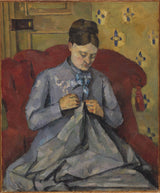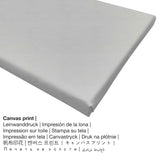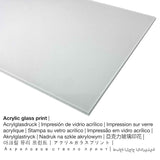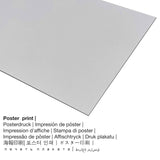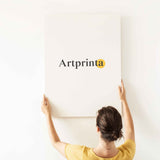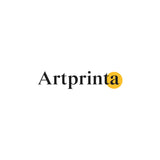Paul Cézanne, 1877 - Eserese nwunye nke Artist - ọmarịcha nka
Ụtụ gụnyere. Mbupu gbakọrọ na ndenye ọpụpụ.
Nkọwa ngwaahịa nka
Nke a kariri 140 afọ nka nka aha ya Portrait of the Artist's Wife kere site na onye echiche nwe- Paul Cézanne. Ụdị ihe osise ahụ nwere nha ndị a: Ogologo: 59,5 cm (23,4 ″); Obosara: 49,5 cm (19,4 ″) Ekebere: Elu: 75 cm (29,5 ″); Obosara: 64,5 cm (25,3 ″); Omimi: 9 cm (3,5 ″). Mmanụ na kwaaji was applied by the French artist as the technique for the piece of art. Nowadays, this artwork belongs to the National Museum nke Stockholm digital art collection, nke bụ Sweden ngosi nka nka na imewe, a Swedish ọchịchị ikike na a mandatet o chekwa omenala nketa na-akwalite art, mmasị nka na ihe ọmụma nka. Site n'ikike nke: Nationalmuseum Stockholm & Wikimedia Commons (ọha na eze).: . N'elu nke ahụ, nhazi nke mmepụta dijitalụ bụ Eserese ma nwee oke nke 1: 1.2, nke pụtara na ogologo bụ 20% mkpụmkpụ karịa obosara. The painter Paul Cézanne was a European artist, whose style can be classified as Impressionism. The French painter lived for 67 afọ and was born in the year 1839 and died in the year 1906 in Aix-en-Provence.
Họrọ ihe kacha amasị gị
N'ime ndepụta ndetu ngwaahịa ị nwere ike họrọ ihe na nha nke nhọrọ gị. Nha na ihe ndị a bụ nhọrọ anyị na-enye gị maka nkeonwe:
- Akwụkwọ mmado ebipụtara (akwa akwa akwa): Our poster is a printed sheet of canvas paper with a granular surface finish, that resembles the actual work of art. Please keep in mind, that depending on the absolute size of the poster we add a white margin 2-6cm round about the work of art in order to facilitate the framing with your custom frame.
- Mbipụta kwaaji: The canvas print, not to be confused with a canvas painting, is an image printed on an industrial printer. The printed canvas makes a familiar and pleasant ambience. Hanging a canvas print: The great advantage of canvas prints is that they are relatively low in weight. This means, it is quite simple to hang up the Canvas print without the support of additional wall-mounts. Therefore, a canvas print is suited for all types of walls.
- Mbipụta ọla (aluminium dibbond): Aluminium Dibond prints are prints on metal with an impressive effect of depth - for a modern look and non-reflective surface. A direct Direct Print on Aluminum Dibond is the best start to fine art reproductions made with aluminum. The white & bright parts of the original work of art shimmer with a silky gloss but without the glow.
- Glass acrylic e biri ebi (nwere ezigbo mkpuchi iko): An acrylic glass print, which is often described as a fine art print on plexiglass, makes the original into beautiful décor. The work of art is manufactured with modern UV direct print machines. The result of this are sharp, rich colors. The great advantage of a plexiglass print is that contrasts plus minor image details become visible because of the precise tonal gradation. Our acrylic glass protects your chosen art replica against sunlight and heat for many more years to come.
Nkwupụta iwu: We try all that we can to describe our art products as accurate as possible and to display them visually in our shop. Nevertheless, the colors of the print materials, as well as the imprint can differ somehwat from the presentation on your device's screen. Depending on your settings of your screen and the condition of the surface, not all color pigments are printed one hundret percent realistically. Because all are printed and processed by hand, there might as well be minor variations in the motif's size and exact position.
Ozi ihe ahaziri ahazi
| Nkewa edemede: | nka nka |
| Mmeputakwa: | dijitalụ mmeputakwa |
| Usoro mmepụta: | Mbipụta UV ozugbo |
| Mmalite ngwaahịa: | arụpụtara na Germany |
| Stockdị ngwaahịa: | mmepụta ihe na-achọ |
| A na-atụ aro iji ngwaahịa eme ihe: | Ụlọ ihe osise nka, mkpokọta nka (mmepụta) |
| Nhazi: | nhazi ihe osise |
| Oke akụkụ onyonyo: | (ogologo: obosara) 1: 1.2 |
| Mmetụta akụkụ onyonyo: | ogologo bụ 20% mkpụmkpụ karịa obosara |
| Nhọrọ akụrụngwa: | akwụkwọ mmado (akwụkwọ kwaaji), mbipụta ọla (aluminium dibond), mbipụta iko acrylic (nke nwere ezigbo mkpuchi iko), mbipụta akwụkwọ. |
| Nha n'arọwa n'elu ihe ndọtị (mbipụta akwa akwa): | 50x60cm - 20x24", 100x120cm - 39x47", 150x180cm - 59x71" |
| Mbipụta iko acrylic (nwere ezigbo mkpuchi iko) dị iche iche: | 50x60cm - 20x24", 100x120cm - 39x47" |
| Mpempe akwụkwọ mmado (akwụkwọ kwaaji) nha: | 50x60cm - 20x24", 100x120cm - 39x47" |
| Nhọrọ aluminom dibond (ihe aluminom) nhọrọ: | 50x60cm - 20x24", 100x120cm - 39x47" |
| Nhazi nke nka nka: | na-enweghị etiti |
Nkọwa ahaziri nke ihe osise
| Aha nka nka: | "Portrait of the Artist's Wife" |
| Nhazi nka nka: | sere |
| Okwu mkpokọta: | nkà nke oge a |
| Narị afọ nka: | 19th narị afọ |
| Year: | 1877 |
| Afọ nka: | gbara afọ 140 |
| Ọkara nke ihe osise izizi: | mmanụ na kwaaji |
| Nha izizi nka: | Ogologo: 59,5 cm (23,4 ″); Obosara: 49,5 cm (19,4 ″) Ekebere: Elu: 75 cm (29,5 ″); Obosara: 64,5 cm (25,3 ″); Omimi: 9 cm (3,5 ″) |
| Ụlọ ihe ngosi nka / mkpokọta: | National Museum nke Stockholm |
| Ebe ngosi nka: | Stockholm, Obodo Stockholm, Sweden |
| website: | National Museum nke Stockholm |
| License: | ngalaba ọha |
| Site n'aka: | Nationalmuseum Stockholm na Wikimedia Commons |
Nchịkọta dị mkpirikpi nke onye na-ese ihe
| Aha onye nka: | Paul Cézanne |
| okike nke onye nka: | nwoke |
| Nationality: | French |
| Ọrụ nke onye na-ese ihe: | onye na-ese ihe |
| Obodo onye nka: | France |
| nhazi ọkwa: | omenkà nke oge a |
| Ụdị nke onye na-ese ihe: | Mmetụta |
| Akwụsị: | 67 afọ |
| Amụrụ n'afọ: | 1839 |
| Afọ ọnwụ: | 1906 |
| Nwuru na (ebe): | Aix na Provence |
© Nwebiisinka - ikike ọgụgụ isi nke - www.artprinta.com (Artprinta)
Ozi izizi gbasara nka nke ihe ngosi nka (© - nke Nationalmuseum Stockholm - www.nationalmuseum.se)
English: This is one of Cézanne's many portraits of his wife Hortense Fiquet. They met in 1869, when she was working as a model. Their son was born in 1872, but they did not marry until 1886 – because Cézanne was afraid of how his father would react. Cézanne rarely dated his paintings, but the yellowish wallpaper in the background, with its characteristic blue pattern, makes it possible to date the portrait. This particular wallpaper indicates that the painting is from the Paris flat that the couple rented for a short period in 1877. Denna målning är ett av de många porträtt Cézanne utförde av sin hustru Hortense Fiquet. De hade träffats 1869, när hon arbetade som modell. Deras son föddes 1872, men de gifte sig först 1886 – Cézanne oroade sig länge för sin fars reaktion. Cézanne daterade sällan sina målningar. Men bakgrundens gulaktiga tapet med sitt karaktäristiska blå mönster har i det här fallet gjort det möjligt att tidsbestämma porträttet. Just denna tapet fanns nämligen i den Parislägenhet som paret hyrde under en kort period 1877.

